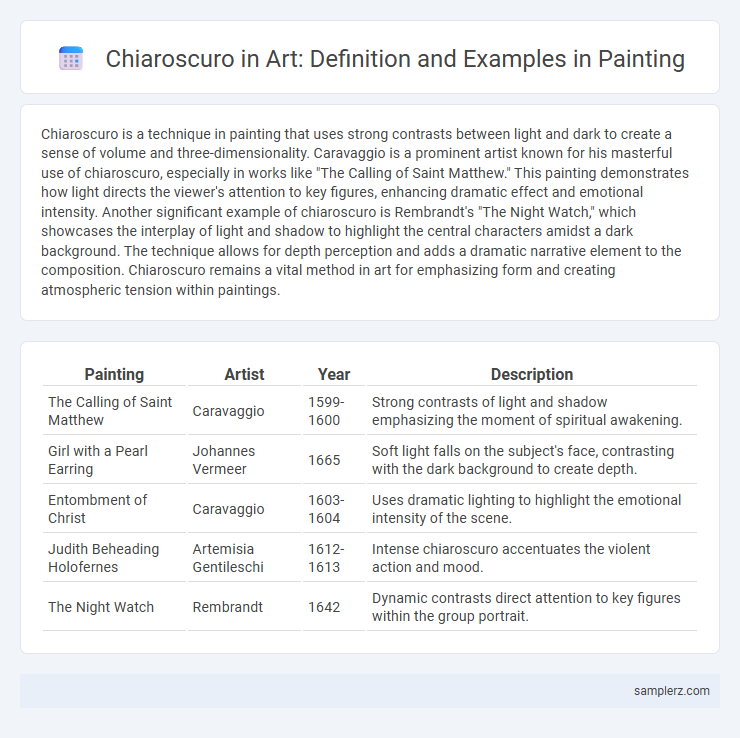Chiaroscuro is a technique in painting that uses strong contrasts between light and dark to create a sense of volume and three-dimensionality. Caravaggio is a prominent artist known for his masterful use of chiaroscuro, especially in works like "The Calling of Saint Matthew." This painting demonstrates how light directs the viewer's attention to key figures, enhancing dramatic effect and emotional intensity. Another significant example of chiaroscuro is Rembrandt's "The Night Watch," which showcases the interplay of light and shadow to highlight the central characters amidst a dark background. The technique allows for depth perception and adds a dramatic narrative element to the composition. Chiaroscuro remains a vital method in art for emphasizing form and creating atmospheric tension within paintings.
Table of Comparison
| Painting | Artist | Year | Description |
|---|---|---|---|
| The Calling of Saint Matthew | Caravaggio | 1599-1600 | Strong contrasts of light and shadow emphasizing the moment of spiritual awakening. |
| Girl with a Pearl Earring | Johannes Vermeer | 1665 | Soft light falls on the subject's face, contrasting with the dark background to create depth. |
| Entombment of Christ | Caravaggio | 1603-1604 | Uses dramatic lighting to highlight the emotional intensity of the scene. |
| Judith Beheading Holofernes | Artemisia Gentileschi | 1612-1613 | Intense chiaroscuro accentuates the violent action and mood. |
| The Night Watch | Rembrandt | 1642 | Dynamic contrasts direct attention to key figures within the group portrait. |
Introduction to Chiaroscuro in Art
Chiaroscuro in painting utilizes strong contrasts between light and dark to create a dramatic sense of volume and depth. Caravaggio's "The Calling of Saint Matthew" exemplifies this technique, where intense lighting highlights key figures against dark backgrounds, enhancing emotional impact. This interplay of shadows and illumination defines chiaroscuro's role in emphasizing three-dimensionality and realism in art.
Historical Origins of Chiaroscuro Painting
Chiaroscuro painting originated during the Italian Renaissance, with artists like Leonardo da Vinci and Caravaggio pioneering the technique to create dramatic contrasts between light and shadow. This method enhanced the three-dimensionality and emotional intensity in portraiture and religious scenes. The historical development of chiaroscuro significantly influenced Baroque painters, solidifying its role in Western art history.
Caravaggio: Master of Chiaroscuro
Caravaggio revolutionized the use of chiaroscuro by creating dramatic contrasts between light and dark, intensifying emotional impact in works such as "The Calling of Saint Matthew" and "Judith Beheading Holofernes." His mastery of tenebrism, a technique emphasizing stark illumination against deep shadows, highlighted figures with striking realism and theatricality. This innovative use of light and shadow profoundly influenced Baroque painting and established Caravaggio as a pivotal figure in art history.
Rembrandt’s Use of Light and Shadow
Rembrandt's mastery of chiaroscuro is evident in his painting "The Night Watch," where he skillfully contrasts intense light and deep shadow to create dramatic depth and focus. The interplay of light highlights key figures, guiding the viewer's eye through the composition while enhancing the three-dimensionality of the scene. This technique exemplifies Rembrandt's innovative approach to capturing emotion and realism through the careful manipulation of light and shadow.
Leonardo da Vinci’s Chiaroscuro Techniques
Leonardo da Vinci's chiaroscuro techniques demonstrate masterful manipulation of light and shadow to create depth and volume in painting. His use of sfumato, a technique blending tones and colors softly, enhances the naturalistic effect of chiaroscuro in works like the "Virgin of the Rocks" and "St. John the Baptist." This approach revolutionized Renaissance art by adding three-dimensional realism and emotional intensity through subtle gradations of light and dark.
Baroque Era Examples of Chiaroscuro
Caravaggio's "The Calling of Saint Matthew" exemplifies Baroque chiaroscuro through its dramatic interplay of light and shadow that highlights the central figures against a dark background. Rembrandt's portraits, such as "The Night Watch," utilize chiaroscuro to create depth and emphasize emotional intensity by contrasting illuminated faces with shadowed surroundings. Artemisia Gentileschi's "Judith Slaying Holofernes" demonstrates chiaroscuro by intensifying the violent scene with stark lighting that draws attention to the characters' expressions and actions.
Chiaroscuro in Religious Paintings
Chiaroscuro technique dramatically enhances religious paintings by emphasizing the contrast between light and dark to evoke spiritual intensity. Caravaggio's "The Calling of Saint Matthew" exemplifies this with its stark illumination drawing focus to divine intervention amidst shadowed surroundings. This interplay of light and darkness underscores themes of revelation and salvation in sacred art.
Dramatic Portraits and Chiaroscuro Effects
Dramatic portraits by artists like Caravaggio exemplify chiaroscuro effects through intense contrasts between light and shadow, enhancing emotional depth and realism. Rembrandt's self-portraits also showcase chiaroscuro by using subtle gradations of light to emphasize facial contours and expressions. This technique creates a three-dimensional appearance, adding intensity and focus to key elements within the composition.
Chiaroscuro in Modern and Contemporary Art
Chiaroscuro in modern and contemporary art intensifies dramatic contrasts between light and shadow, as exemplified in Edward Hopper's "Nighthawks," where the stark interplay highlights urban isolation. Artists like Francis Bacon use chiaroscuro to evoke psychological tension and distorted forms, creating a visceral emotional response. This technique continues to evolve, influencing digital art and photography by enhancing depth and mood through controlled light manipulation.
How to Identify Chiaroscuro in Paintings
Chiaroscuro in paintings is identified by the dramatic contrast between light and dark areas, which creates a sense of volume and three-dimensionality. Look for strong shadows set against illuminated portions, often highlighting specific elements or figures to enhance depth and emotional intensity. Artists like Caravaggio and Rembrandt famously used chiaroscuro to emphasize facial expressions and create a striking visual focus within their compositions.

example of chiaroscuro in painting Infographic
 samplerz.com
samplerz.com